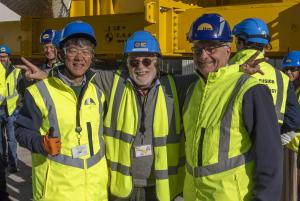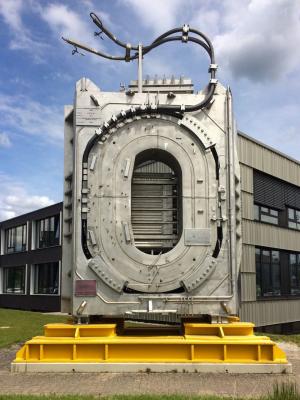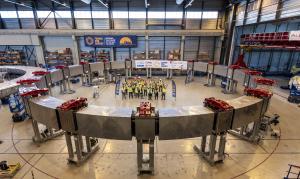Involvement does not stop with delivery
On Friday 15 December 2023, as staff posed for a group photo in front of newly arrived toroidal field coil #18, Alessandro Bonito-Oliva, Head of the Tokamak Program at ITER since 1 November, was still wearing his Fusion for Energy hard hat. Whether an oversight or deliberate, it hinted at the immense collaborative effort under European responsibility to manufacture and deliver ten first-of-a-kind superconducting toroidal field coils, each as tall as a five-storey building and as heavy as a fully loaded Boeing 747.
The delivery of the massive component marked the completion not only of the European procurement program, but that of the project-wide effort to procure 19 D-shaped coils (including one spare) for the ITER machine. For Alessandro, who had managed the magnets program of the European Domestic Agency for more than 15 years, it was "mission accomplished." As part of the ITER Organization now, "Sandro" will oversee the integration of the coils into the machine—a potent illustration of the push to ensure that competencies developed in the ITER Domestic Agencies are not lost during the machine assembly phase.
Sandro and ITER met in 1993, long before the design of the machine was finalized. A theoretical physicist by training and an expert in the quantic sorceries of superconductivity, he had been working for industry since 1986, participating in the early developments of magnetic resonance imaging (MRI), venturing into superconducting motor research (a technological impasse), and contributing to CERN's Large Electron-Positron's (LEP's) magnets before entering the world of fusion at the Next European Torus (NET) project.
In the meantime, the ITER project was gradually acquiring substance, with the manufacturing and full testing of a "toroidal field model coil" in the planning. Ansaldo, the Italian company for which Sandro was working at the time, was among the contractors involved. That was his first encounter with ITER and its monumental magnets. "The shape of the model was more like a racetrack, and its size was about one-third that of the present D-shaped coils, but it was totally relevant from a technological point of view," he remembers.
Following that experience Sandro moved to Oxford Instruments in 1997, a major actor in the field of superconducting magnets where he was to spend close to 10 years, followed by a stint at the National High Magnetic Field Laboratory in Florida. The early ITER experience however had struck a chord. "I had this dream of going back to the ITER project and completing the job started with the model coil and being responsible for the development and production of the actual toroidal field coils."
In the early days of 2008, the dream became reality. In Saint-Paul-lez-Durance, France, the 42-hectare scientific platform was being levelled and equipped, while each Member was establishing a Domestic Agency to procure machine components and industrial systems. Ten toroidal field coils out of a total 19 fell under Europe's scope; another 9 fell under Japan's. For Fusion for Energy, the European Domestic Agency, Sandro was the right man to lead the production of the components: a physicist who knew "what's behind the equations" and someone with enough industrial experience to manage the delicate relationship between supplier and customer, to understand the difficulties, needs and points of view of both sides and to appreciate the technological complexity.
"Toroidal field coils are by far the most technologically complex superconducting magnets ever manufactured and one of most complex components in the whole ITER machine," says Sandro. "Think of the precision (0.001% over a kilometre of conductor length) required when matching the conductor to the 750 metres of grooves in the radial plates on a double spiral trajectory. Think of the 1.5 kilometres of laser welding for the radial plate covers, or of the heat treatment at 650 °C required by the brittle niobium-tin compound!"
However daunting, the challenges were met. By September 2013, the first double pancakes had entered production in Italy and less than seven years later the first European coil was ready for shipping. Between April 2020 and December 2023, Europe delivered the full scope of 10 toroidal field coils to the ITER site. All in all, over the years, 700 people from nearly 50 companies were involved in the manufacturing process. Ten thousand miles away in Japan, a similar process resulted in the supply of 9 toroidal field coils to the ITER Organization.
At the same time, Sandro's responsibilities had expanded: appointed Magnets Head of Unit by Fusion for Energy in 2013, the production of the ring-shaped poloidal field coils entrusted to Europe now fell under his responsibility. "This new project was the most complex in terms of project management," Sandro recalls. "First, we needed to put together a large onsite factory, where 6 different suppliers and about 100 workers and engineers would have to work side by side. But even more important was the necessity of creating a 'team spirit' between all the entities, contractors and individuals—a challenge we achieved over time with effort ... and a good number of celebrations!" In 2023, with only a few tasks to complete on the final poloidal field coil, it was again "mission accomplished" for Sandro. What to do now that the "dream of his life" had been realized?
A new idea began to grow as Sandro spent six months in Naka, Japan, working on the JT-60SA tokamak to repair the electrical insulation of the different superconducting coils after an electrical event had caused a pause in commissioning. "It was the first time I found myself in front of a completely assembled tokamak and it was an inspiring experience—after all, superconducting magnets are not just works of art, they are an integral part of the tokamak machine..." Joining the ITER assembly project was a natural next step and part of an ultimate mission—producing a working ITER machine.
To his new job, Sandro brings the important perspective of having worked on the supplier side. "Relations between the ITER Organization and the Domestic Agencies are complex because within a shared objective the approach can differ depending on whether you are reasoning as a supplier or as the machine owner." Under the re-organization currently underway at the ITER Organization, there is a definite will to integrate these perspectives, along with talent from the Domestic Agencies, in order to optimize the continuity from design to manufacturing to assembly and eventual operation.
It is important, for instance, that a Domestic Agency's involvement does not stop with the delivery of components. "When you've produced a technically complex component and accumulated all the technical knowhow, you can make a real contribution onsite during integration and commissioning. My first months here have been an incredible source of motivation, which at this advanced stage of my career I thought would be impossible to find. I would strongly encourage others to follow in my steps!"




